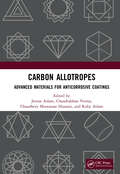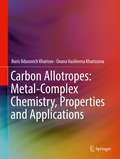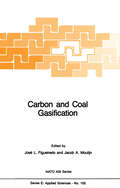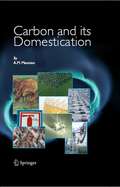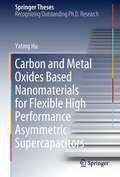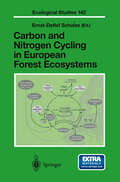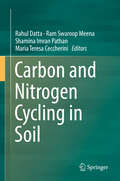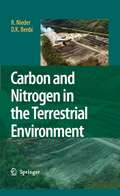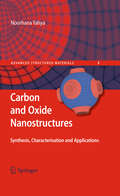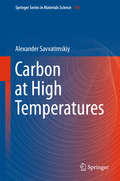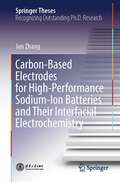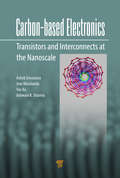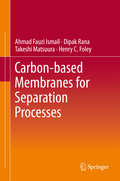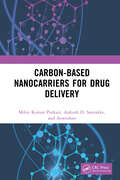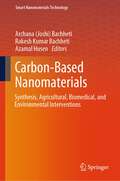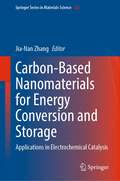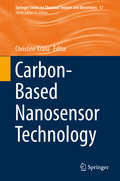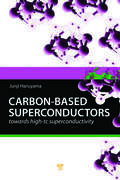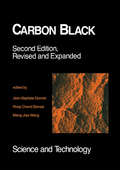- Table View
- List View
Carbon-13 NMR Spectral Problems (Organic Chemistry)
by Robert B. Bates William A. BeaversWith the advent of Fourier transform spectrometers of great sensitivity, it has become practical to obtain carbon-13 nuclear magnetic resonance (C-13 NMR; l3C NMR; CMR) spectra routinely on organic molecules, and this technique has become one of the highest utility in determining structures of organic unknowns. When the usual spectrometric techniques proton magnetic resonance (H-I NMR; IH NMR; PMR), infrared (lR), mass (MS), and ultraviolet (UV)-do not readily reveal a compound's structure, a C-13 NMR spectrum will often provide sufficient additional information to yield it unequivocally. With this in mind, the present work was designed to give advanced undergraduates, graduate students, and practicing chemists a working knowledge of and facility with the use of this valuable technique. Some familiarity with other spectrometric techniques is assumed (recommended book: Silverstein, Bassler, and Morrill, Spectrometric Identification of Organic Compounds), but no prior knowledge of C-13 NMR -which is treated very lightly, if at all, in the widely used elementary organic texts-is necessary. A discussion of C-13 NMR spectroscopy is followed by 125 problems, each consisting of a molecular formula, two types of C-13 NMR spectra (partially and completely proton decoupled, with connecting lines to facilitate multiplicity assignments), an integrated H-I NMR spectrum, and the most important IR, UV, and MS data. These problems have been very carefully prepared, thoroughly tested by students at the University of Arizona, and we believe that very few errors remain.
Carbon Allotropes: Advanced Materials for Anticorrosive Coatings
by Jeenat Aslam Chandrabhan Verma Chaudhery Mustansar Hussain Ruby AslamThe study of corrosion-resistant coatings using nanostructured materials is developing and growing at a very rapid rate. Carbon Allotropes: Advanced Anticorrosive Coatings Materials summarizes current research and technology on the significance of carbon allotropes in anticorrosive coatings. The book describes the synthesis, characterization, inhibitory mechanism, and industrial applications of carbon allotropes as a corrosion-resistant coating. The usage of carbon allotropes as nanostructure materials based on corrosion-resistant coatings used in contemporary industrial platforms is discussed in this book. Additionally, this book assesses the potential of carbon allotropes as the foundation for corrosion-resistant nanostructure materials and coatings. For scientists and engineers looking for cutting-edge ideas for nanostructures based on carbon allotropes as corrosion-resistant coating materials, this book is an invaluable resource. Salient Features This book covers nanostructured carbon allotropes as materials for corrosion-resistant coatings. The use of carbon allotropes as anticorrosive has revolutionized modern industrial practices. This offers academics and entrepreneurs an influential foundational, interdisciplinary, and primary literature reading. The most cutting-edge coatings based on carbon allotropes are also highlighted, along with current manufacturing and operating challenges. This maintains ongoing research on corrosion-resistant coatings using nanostructured materials while incorporating fresh advancements across the entire area.
Carbon Allotropes: Metal-Complex Chemistry, Properties and Applications
by Boris Ildusovich Kharisov Oxana Vasilievna KharissovaThis book provides a detailed description of metal-complex functionalized carbon allotrope forms, including classic (such as graphite), rare (such as M- or T-carbon), and nanoforms (such as carbon nanotubes, nanodiamonds, etc.). Filling a void in the nanotechnology literature, the book presents chapters generalizing the synthesis, structure, properties, and applications of all known carbon allotropes. Metal-complex composites of carbons are described, along with several examples of their preparation and characterization, soluble metal-complex carbon composites, cost-benefit data, metal complexes as precursors of carbon allotropes, and applications. A lab manual on the synthesis and characterization of carbon allotropes and their metal-complex composites is included.Provides a complete description of all carbon allotropes, both classic and rare, as well as carbon nanostructures and their metal-complex composites;Contains a laboratory manual of experiments on the synthesis and characterization of metal-complex carbon composites;Discusses applications in diverse fields, such as catalysis on supporting materials, water treatment, sensors, drug delivery, and devices.
Carbon Allotropes: Advanced Materials for Anticorrosive Coatings
The study of corrosion-resistant coatings using nanostructured materials is developing and growing at a very rapid rate. Carbon Allotropes: Advanced Anticorrosive Coatings Materials summarizes current research and technology on the significance of carbon allotropes in anticorrosive coatings. The book describes the synthesis, characterization, inhibitory mechanism, and industrial applications of carbon allotropes as a corrosion-resistant coating. The usage of carbon allotropes as nanostructure materials based on corrosion-resistant coatings used in contemporary industrial platforms is discussed in this book. Additionally, this book assesses the potential of carbon allotropes as the foundation for corrosion-resistant nanostructure materials and coatings. For scientists and engineers looking for cutting-edge ideas for nanostructures based on carbon allotropes as corrosion-resistant coating materials, this book is an invaluable resource. Salient Features This book covers nanostructured carbon allotropes as materials for corrosion-resistant coatings. The use of carbon allotropes as anticorrosive has revolutionized modern industrial practices. This offers academics and entrepreneurs an influential foundational, interdisciplinary, and primary literature reading. The most cutting-edge coatings based on carbon allotropes are also highlighted, along with current manufacturing and operating challenges. This maintains ongoing research on corrosion-resistant coatings using nanostructured materials while incorporating fresh advancements across the entire area.
Carbon and Coal Gasification: Science and Technology (NATO Science Series E: #105)
by J. L. Figueiredo Jacob A. MoulijnCarbon gasification reactions form the basis of many important industrial processes, such as the combustion of coal and the produc tion of synthesis gas, fuel gases and activated carbons. They are also involved in metallurgical processes and in the regeneration of coked catalysts. Thus, understanding the fundamentals of carbon gasification is of vital importance for further technological development. Moreover, the subject is of interdisciplinary nature, involving chemistry, ma terials science and chemical engineering. Therefore, it was thought that an Advanced Study Institute would be fruitful in establishing the state of the art, in bringing together experts from the various sectors involved and in identifying areas of required research and industrial development. Such a meeting was held at Alvor, Portugal, from the 20th to the 31st May 1985, and the lectures presented the reof are collected in this volume. The present volume is organized in seven chapters. The Intro duction presents the carbon gasification reactions an~ their rele vance for particular processes and industrial uses. In the second chapter, the structures of carbon and coal are reviewed, together with methods of structural, chemical and textural characterization.
Carbon and Its Domestication
by A.M. MannionCarbon is a vital component of environmental and economic systems. Its unique chemistry makes it important biologically, geologically, and climatically. Its domestication in time and space has many manifestations, including the control of fire, development of agriculture, fossil-fuel use and biotechnology. All have exacted an environmental price. Many agencies exist to manage carbon through conservation, etc. Carbon management is now a highly charged international political issue in which energy provision is a primary factor. This cross-disciplinary text focuses on the pivotal role of carbon in society and in the environment.
Carbon and Metal Oxides Based Nanomaterials for Flexible High Performance Asymmetric Supercapacitors (Springer Theses)
by Yating HuThis thesis examines electrode materials such as mesoporous carbons, manganese oxides, iron oxides and their nanohybrids with graphene. It also explores several of the key scientific issues that act as the governing principles for future development of supercapacitors, which are a promising class of high-efficiency energy storage devices for tackling a key aspect of the energy crisis. However, critical technical issues, such as the low energy density and reliability, need to be addressed before they can be extended to a wide range of applications with much improved performance. Currently available material candidates for the electrodes all have their disadvantages, such as a low specific capacitance or poor conductivity for transition metal oxide/hydroxide-based materials. This thesis addresses these important issues, and develops a high-performance, flexible asymmetric supercapacitor with manganese oxides/reduced graphene oxide as the positive electrode and iron oxide/reduced graphene oxide as the anode, which delivers a high energy density of 0.056 Wh cm-3.
Carbon and Nitrogen Cycling in European Forest Ecosystems (Ecological Studies #142)
by Ernst-Detlef SchulzeThis volume quantifies carbon storage in managed forest ecosystems not only in biomass, but also in all soil compartments. It investigates the interaction between the carbon and nitrogen cycles by working along a north-south transect through Europe that starts in northern Sweden, passes through a N-deposition maximum in central Europe and ends in Italy. For the first time biogeochemical processes are linked to biodiversity on a large geographic scale and with special focus on soil organisms. The accompanying CD-ROM provides a complete database of all flux, storage and species observations for modellers.
Carbon and Nitrogen Cycling in Soil
by Rahul Datta Ram Swaroop Meena Shamina Imran Pathan Maria Teresa CeccheriniSeveral textbooks and edited volumes are currently available on general soil fertility but‚ to date‚ none have been dedicated to the study of “Sustainable Carbon and Nitrogen Cycling in Soil.” Yet this aspect is extremely important, considering the fact that the soil, as the ‘epidermis of the Earth’ (geodermis)‚ is a major component of the terrestrial biosphere. This book addresses virtually every aspect of C and N cycling, including: general concepts on the diversity of microorganisms and management practices for soil, the function of soil’s structure-function-ecosystem, the evolving role of C and N, cutting-edge methods used in soil microbial ecological studies, rhizosphere microflora, the role of organic matter (OM) in agricultural productivity, C and N transformation in soil, biological nitrogen fixation (BNF) and its genetics, plant-growth-promoting rhizobacteria (PGPRs), PGPRs and their role in sustainable agriculture, organic agriculture, etc. The book’s main objectives are: (1) to explain in detail the role of C and N cycling in sustaining agricultural productivity and its importance to sustainable soil management; (2) to show readers how to restore soil health with C and N; and (3) to help them understand the matching of C and N cycling rules from a climatic perspective.Given its scope, the book offers a valuable resource for educators, researchers, and policymakers, as well as undergraduate and graduate students of soil science, soil microbiology, agronomy, ecology, and the environmental sciences. Gathering cutting-edge contributions from internationally respected researchers, it offers authoritative content on a broad range of topics, which is supplemented by a wealth of data, tables, figures, and photographs. Moreover, it provides a roadmap for sustainable approaches to food and nutritional security, and to soil sustainability in agricultural systems, based on C and N cycling in soil systems.
Carbon and Nitrogen in the Terrestrial Environment
by R. Nieder D.K. BenbiCarbon and Nitrogen in the Terrestrial Environment is a comprehensive, interdisciplinary description of C and N fluxes between the atmosphere and the terrestrial biosphere; issues related to C and N management in different ecosystems and their implications for the environment and global climate change; and the approaches to mitigate emission of greenhouse gases. Drawing upon the most up-to-date books, journals, bulletins, reports, symposia proceedings and internet sources documenting interrelationships between different aspects of C and N cycling in the terrestrial environment, Carbon and Nitrogen in the Terrestrial Environment fills the gap left by most of the currently available books on C and N cycling. They either deal with a single element of an ecosystem, or are related to one or a few selected aspects like soil organic matter (SOM) and agricultural or forest management, emission of greenhouse gases, global climate change or modeling of SOM dynamics.
Carbon and Oxide Nanostructures: Synthesis, Characterisation and Applications (Advanced Structured Materials #5)
by Noorhana YahyaThis volume covers all aspects of carbon and oxide based nanostructured materials. The topics include synthesis, characterization and application of carbon-based namely carbon nanotubes, carbon nanofibres, fullerenes, carbon filled composites etc. In addition, metal oxides namely, ZnO, TiO2, Fe2O3, ferrites, garnets etc., for various applications like sensors, solar cells, transformers, antennas, catalysts, batteries, lubricants, are presented. The book also includes the modeling of oxide and carbon based nanomaterials. The book covers the topics: Synthesis, characterization and application of carbon nanotubes, carbon nanofibres, fullerenes Synthesis, characterization and application of oxide based nanomaterials. Nanostructured magnetic and electric materials and their applications. Nanostructured materials for petro-chemical industry. Oxide and carbon based thin films for electronics and sustainable energy. Theory, calculations and modeling of nanostructured materials.
Carbon at High Temperatures (Springer Series in Materials Science #134)
by Alexander SavvatimskiyThis book deals with the properties and behavior of carbon at high temperatures. It presents new methods and new ways to obtain the liquid phase of carbon. Melting of graphite and the properties of liquid carbon are presented under stationary heat and pulse methods. Metal like properties of molten graphite at high initial density are indicated. A new possible transition of liquid carbon from metal to nonmetal behavior much above the melting point is mentioned. Methodical questions of pulse heating, in particular the role of pinch-pressure in receiving a liquid state of carbon, are discussed. The reader finds evidence about the necessity of applying high pressure (higher than 100 bar) to melt graphite (melting temperature 4800±100 K). The reader can verify the advantage of volume pulse electrical heating before surface laser heating to study the physical properties of carbon, including enthalpy, heat capacity, electrical resistivity and temperature. The advantages of fast heating of graphite by pulsed electric current during a few microseconds are shown. The data obtained for the heat capacity of liquid carbon under constant pressure and constant volume were used to estimate the behavior at temperatures much higher 5000 K.
Carbon-Based Electrodes for High-Performance Sodium-Ion Batteries and Their Interfacial Electrochemistry (Springer Theses)
by Jun ZhangThis book focuses on the development of high-performance carbon electrodes for sodium ion batteries (SIBs). By proposing folded-graphene as the high-density cathode with excellent rate capability, it provides insight into the interplay between oxygen functional groups and folded texture. It also highlights the superiority of ether electrolytes matching with carbon anodes, which are shown to deliver largely improved electrochemical performance. The achievements presented offer a valuable contribution to the carbon-based electrodes in SIBs.
Carbon-Based Electronics: Transistors and Interconnects at the Nanoscale
by Ashok Srivastava Jose Mauricio Marulanda Yao Xu Ashwani SharmaDiscovery of one-dimensional material carbon nanotubes in 1991 by the Japanese physicist Dr. Sumio Iijima has resulted in voluminous research in the field of carbon nanotubes for numerous applications, including possible replacement of silicon used in the fabrication of CMOS chips. One interesting feature of carbon nanotubes is that these can be me
Carbon-based Membranes for Separation Processes
by Ahmad Fauzi Ismail Dipak Rana Takeshi Matsuura Henry C. FoleyThis book provides a significant overview of carbon-related membranes. It will cover the development of carbon related membranes and membrane modules from its onset to the latest research on carbon mixed matrix membranes. After reviewing progress in the field, the authors indicate future research directions and prospective development. The authors also attempt to provide a guideline for the readers who would like to establish their own laboratories for carbon membrane research. For this purpose, detailed information on preparation, characterization and testing of various types of carbon membrane is provided. Design and construction of carbon membrane modules are also described in detail.
Carbon-Based Nanocarriers for Drug Delivery
by Mihir Kumar Purkait Ankush D. Sontakke AnweshanCarbon-Based Nanocarriers for Drug Delivery enlists the latitudes and advancements in the synthesis processes, functionalization, and applications of carbon-based nanomaterials (CBNs) in targeted drug delivery systems (DDSs). It covers the applicability and suitability of CBNs as nanocarriers for efficient drug delivery application via elucidating the recent advancements in CBNs, their functionalized and innovative derivatives, and the relevant case studies. The book explores the necessity, efficacy, toxicological aspects, and challenges for the application of CBN in targeted DDSs. Some of the features of this book are provided as follows: Provides elaborative description on significance and adaptability of carbon-based nanomaterial in targeted drug delivery for wide ranges of therapeutics Delivers a full-spectrum discussion on drug delivery through carbon-based nanocarriers Explores each carbon-based nanocarrier fundamentally for its drug and gene-delivery-related applications Describes critical discussion on various toxicological effects over the utilization of these nanocarriers Embraces existing as well as novel technologies/methodologies related to the synthesis and functionalization of CBNs, including graphene, graphene oxide, carbon quantum dots, carbon nanotube, fullerene, and smart carbon-based nanocarriers This book is aimed at researchers and graduate students in materials and pharmaceutical engineering, including drug delivery systems.
Carbon-Based Nanocarriers for Drug Delivery
by Mihir Kumar Purkait Ankush D. Sontakke AnweshanCarbon-Based Nanocarriers for Drug Delivery enlists the latitudes and advancements in the synthesis processes, functionalization, and applications of carbon-based nanomaterials (CBNs) in targeted drug delivery systems (DDSs). It covers the applicability and suitability of CBNs as nanocarriers for efficient drug delivery application via elucidating the recent advancements in CBNs, their functionalized and innovative derivatives, and the relevant case studies. The book explores the necessity, efficacy, toxicological aspects, and challenges for the application of CBN in targeted DDSs. Some of the features of this book are provided as follows: Provides elaborative description on significance and adaptability of carbon-based nanomaterial in targeted drug delivery for wide ranges of therapeutics Delivers a full-spectrum discussion on drug delivery through carbon-based nanocarriers Explores each carbon-based nanocarrier fundamentally for its drug and gene-delivery-related applications Describes critical discussion on various toxicological effects over the utilization of these nanocarriers Embraces existing as well as novel technologies/methodologies related to the synthesis and functionalization of CBNs, including graphene, graphene oxide, carbon quantum dots, carbon nanotube, fullerene, and smart carbon-based nanocarriers This book is aimed at researchers and graduate students in materials and pharmaceutical engineering, including drug delivery systems.
Carbon-Based Nanomaterials: Synthesis, Agricultural, Biomedical, and Environmental Interventions (Smart Nanomaterials Technology)
by Archana Joshi Bachheti Rakesh Kumar Bachheti Azamal HusenCarbon nanomaterials have several applications, which is driving up scientific research into them. The book showcases the most recent advancements and research discoveries rather than just providing an overview. Each chapter offers authoritative insights into the ever-changing field of carbon-based nanomaterials, as written by top authorities in their respective domains. The book stands out for its persistent focus on real-world application. It is devoted to practical applications and is divided into four sections. The intriguing promise of carbon nanomaterials, their synthesis, and their possible uses set the stage for the adventure. Subsequently, the emphasis shifts to agriculture, where nanomaterials have been shown to improve plant health, fend against illnesses, promote growth and development, and even help detect and remove herbicides. The biomedical part explores the potential toxicological ramifications of these materials while introducing the reader to their ground-breaking role in drug delivery, tissue engineering, and the fight against fungal diseases. Overall, the book provides valuable insights and serves as a comprehensive resource for researchers and scientists across various interdisciplinary subjects.
Carbon-Based Nanomaterials for Energy Conversion and Storage: Applications in Electrochemical Catalysis (Springer Series in Materials Science #325)
by Jia-Nan ZhangThis book systematically summarizes the advanced development of carbon-based nanomaterials for electrochemical catalysis, and it is comprised of four sections. The first section discusses about the fundamental synthesis, characterization techniques, and catalytic effects on the energy conversion and storage mechanism. The second section elaborately reviews various types of electrocatalytic reactions on carbon-based materials and their performance. The third section focuses on batteries about carbon-based materials with different storage mechanism. And the last one, the following enlightenment in terms of theoretical development and experimental research is provided to the general readers: 1) Precise design and construction of local atomic and electronic structures at the interface of catalysts; 2) Selective activation and directed conversion of carbon-based energy-carrying molecules at the interface; 3) Interaction mechanism and regulation of catalyst solid surface interface properties under environment and external field. This book will be useful for researchers and students who are interested in carbon-based nanomaterials, electrochemical catalysts and energy storage.
Carbon-Based Nanosensor Technology (Springer Series on Chemical Sensors and Biosensors #17)
by Christine KranzCarbon nanomaterials have gained relevance in chem/bio sensing applications owing to their unique chemical, mechanical, electrical, and thermal characteristics. Written by leading experts in the field, this book discusses selected, state-of-the art carbon-based nanomaterials, including nanodiamonds, graphene nanodots, carbon nanopores, and nanocellulose. It presents examples of chem/bio sensing applications ranging from biomedical studies, such as DNA sequencing and neurotransmitter sensing, to heavy-metal detection in environmental monitoring scenarios, and reviews the unique properties of carbon-based nanomaterials with respect to targeted sensing applications. Further, it highlights exciting future applications. Providing comprehensive information for practitioners and scientists working in the field of carbon nanomaterial technologies and their application, it is also a valuable resource for advanced students of analytical chemistry, biochemistry, electrochemistry, materials science, and micro-/nanotechnology and -sensing.
Carbon-based Solids and Materials (Iste Ser.)
by Pierre DelhaesIt is well known that solid carbons can be found in various guises with different forms of bulk phases (graphites, diamonds and carbynes) as well as more molecular forms (fullerenes,nanotubes and graphenes) resulting from recent discoveries. The cause of this rich polymorphism is analyzed in the first part of this book (chapters 1-5) with the propensity of carbon atoms for forming different types of homopolar chemical bonds associated with variable coordination numbers. Precursor organic molecules and parent compounds are also described to establish specific links with this rich polymorphism. Then in a second part (chapters 6-10) a comparative review of the main classes of bulk physical properties is presented. This approach emphasizes in particular the electronic behavior of (pi) polyaromatic systems organized in plane and curved atomic sheets. Finally in a third part (chapters 11-15) the surface and interface characteristics are introduced together with the texture and morphology of these multiscale carbon materials. An overview of the main field of applications is related showing the large use and interest for these solids.
Carbon-based Solids and Materials
by Pierre DelhaesIt is well known that solid carbons can be found in various guises with different forms of bulk phases (graphites, diamonds and carbynes) as well as more molecular forms (fullerenes,nanotubes and graphenes) resulting from recent discoveries. The cause of this rich polymorphism is analyzed in the first part of this book (chapters 1-5) with the propensity of carbon atoms for forming different types of homopolar chemical bonds associated with variable coordination numbers. Precursor organic molecules and parent compounds are also described to establish specific links with this rich polymorphism. Then in a second part (chapters 6-10) a comparative review of the main classes of bulk physical properties is presented. This approach emphasizes in particular the electronic behavior of (pi) polyaromatic systems organized in plane and curved atomic sheets. Finally in a third part (chapters 11-15) the surface and interface characteristics are introduced together with the texture and morphology of these multiscale carbon materials. An overview of the main field of applications is related showing the large use and interest for these solids.
Carbon-based Superconductors: Towards High-Tc Superconductivity
by Junji HaruyamaSuperconductors (SCs) are attractive materials in all respects for any community. They provide a deep insight into the physical properties of the condensed matters and also have useful applications as ultra-low-power-dissipation systems that can help resolve the present energy problems. In particular, the recent advancement of carbon-based new supe
Carbon Black: Science and Technology, Second Edition
by Jean-Baptiste DonnetThe second edition of this reference provides comprehensive examinations of developments in the processing and applications of carbon black, including the use of new analytical tools such as scanning tunnelling microscopy, Fourier transform infrared spectroscopy and inverse gas chromatography.;Completely rewritten and updated by numerous experts in the field to reflect the enormous growth of the field since the publication of the previous edition, Carbon Black: discusses the mechanism of carbon black formation based on recent advances such as the discovery of fullerenes; elucidates micro- and macrostructure morphology and other physical characteristics; outlines the fractal geometry of carbon black as a new approach to characterization; reviews the effect of carbon black on the electrical and thermal conductivity of filled polymers; delineates the applications of carbon black in elastomers, plastics, and zerographic toners; and surveys possible health consequences of exposure to carbon black.;With over 1200 literature citations, tables, and figures, this resource is intended for physical, polymer, surface and colloid chemists; chemical and plastics engineers; spectroscopists; materials scientists; occupational safety and health physicians; and upper-level undergraduate and graduate students in these disciplines.
Carbon Black: Science and Technology, Second Edition
by Jean-Baptiste Donnet, Roop Chand Bansal and Meng-Jiao WangThe second edition of this reference provides comprehensive examinations of developments in the processing and applications of carbon black, including the use of new analytical tools such as scanning tunnelling microscopy, Fourier transform infrared spectroscopy and inverse gas chromatography.;Completely rewritten and updated by numerous experts in the field to reflect the enormous growth of the field since the publication of the previous edition, Carbon Black: discusses the mechanism of carbon black formation based on recent advances such as the discovery of fullerenes; elucidates micro- and macrostructure morphology and other physical characteristics; outlines the fractal geometry of carbon black as a new approach to characterization; reviews the effect of carbon black on the electrical and thermal conductivity of filled polymers; delineates the applications of carbon black in elastomers, plastics, and zerographic toners; and surveys possible health consequences of exposure to carbon black.;With over 1200 literature citations, tables, and figures, this resource is intended for physical, polymer, surface and colloid chemists; chemical and plastics engineers; spectroscopists; materials scientists; occupational safety and health physicians; and upper-level undergraduate and graduate students in these disciplines.

